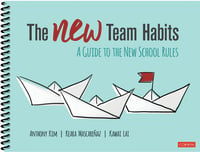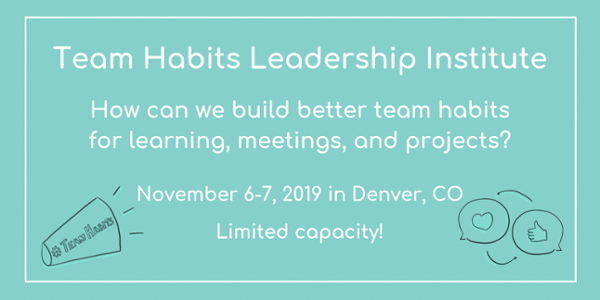
The NEW Team Habits: Fostering a Culture of Belonging Through Meeting Check-Ins
School Districts | Innovative Leadership | Teams & Culture
How are you? What is bringing you to this blog post today? What is top of mind for you as you’re reading this? Would you rather have the ability to fly or read minds?
Did those questions interest or engage you? Are you now mulling over your current feelings or intentions? Or did you stop reading entirely to properly dedicate your attention to choosing between superpowers? Regardless of your actions, the questions I posed required you to pause for a moment, consider your thoughts, and engage with your imagination. These abilities are vital to our roles as educators - we are consistently tasked with keeping calm through perceived chaos, being conscientious of the numerous needs of others, and maintaining a level of creativity to capture the attention of students. Yet in schools and districts across the country, very little time – our most precious resource as educators – is dedicated to the exploration and development of those skills.
Teachers and school leaders consistently report spending an exorbitant amount of time fulfilling their roles while also feeling siloed in their efforts, leaving little opportunity to add any other demands to their plates; despite their professional or topical relevance. In order to address this concern, organizations, scholastic or otherwise, are finding it necessary to revisit their current meeting structures. School teams allocate a significant amount of their time outside of the classroom in meetings, and are realizing the need to receive a greater cultural and developmental return from this investment. This is something we hear often from school teams and recognize in the upcoming book, The NEW Team Habits by Anthony Kim, Keara Mascarenñaz, and Kawai Lai; “For many of us, meetings occupy the majority of our work day. Meetings have the potential to be powerful levers for sharing and collaboration, but unfortunately are often disengaging and inefficient.” Our school teams need to use our time wisely, and currently, most meetings are not time well spent.
The NEW Team Habits is releasing this fall! Co-authored by Anthony Kim, Keara Mascareñaz, and Kawai Lai, The NEW Team Habits is the follow-up guide to the best-selling The NEW School Rules, created to help leadership teams transform the habits that keep them from success. Pre-order now!
Leaders have employed a number of programs and protocols to make meetings more productive and efficient. Many of these structures demonstrate semblances of success at the outset of their implementation, but their effectiveness quickly wears off as long-developed habits and routines return in their place. This cycle often occurs because a problem has been misidentified as being systems-related, resulting in the under-allocation of support for the people-related concerns that are actually present. One cannot facilitate meetings that are more engaging or efficient without first recognizing the needs and contributions of all who are present; one of them being the innate need to belong. This relatively unexplored notion is highlighted in the research of Karyn Twaronite of the Harvard Business Review, who found that, “when people feel like they belong at work, they are more productive, motivated, engaged, and 3.5 times more likely to contribute to their fullest potential.” In order for time spent in meetings to become more impactful and valuable, everyone present requires a level of personal engagement and inclusion that has historically been overlooked in these settings.
Deeper Dive: Check out our Ultimate Guide to Innovative Leadership Development for School Districts to learn about even more strategies for developing the traits of an effective leader – all the way from district leadership to teachers in classrooms.
The NEW Team Habits challenges school teams to broaden their perspectives and see all meeting structures as being spaces to reflect and iterate on their functions as a team. The authors write, “Meetings are a place where we can practice responsive habits by building trust, distributing authority, and clarifying decision making.” People need to feel like their time is being valued and that their voices are being heard. This understanding, combined with a research-based focus on improving the belonging culture within your organization, will help shift a team’s tone and engagement when spending time together, and shift the meeting culture towards one that is more focused on reaching shared goals. As Charles Duhigg shares, there are two key elements present in the meetings of highly effective teams: equality in conversational turn-taking, and ostentatious listening. He writes, “During a meeting, or a set of meetings, if everyone speaks at roughly the same amount, then that team is much more likely to succeed. In addition to encouraging you to talk more, I as a team leader must show you that I’m listening by doing things like repeating what you just told me or closing my computer so I can make eye contact with you.” The way your team starts a meeting has a tremendous impact on how your team is able to embody the above practices. We recommend the specific habit of leading a check-in to start a meeting as an entry point for encouraging equality in conversational turn-taking and ostentatious listening. As we progress through the beginning of the school year, here are 3 tips to create a culture of belonging by intentionally engaging your team’s habits and leading check-ins at meetings:
Related Resource: Download some check-in and check-out questions from The NEW School Rules to spark some initial ideas and help you get started! Download here.
1. Engage your team to learn about disengagement:
To help your team engage in a reflective practice, first have them generate ideas in a playful environment. As a fun opening activity to a meeting, break into small teams and have each team race to create a David Letterman-esque top 10 list of the habits people display when disengaging in meetings, then discuss your lists as a team. Use this conversation to illuminate how these habits might show up in your team meetings, and crowdsource ideas to increase team engagement.
2. Learn from the best
Google studied more than 200 teams as part of Project Aristotle to answer the question: What makes certain teams more effective than others? Your team can either research how successful schools, companies, athletic programs, etc., build highly effective teams and explore key takeaways around how those teams engage in meetings, or use the work Google has already done and as a team, watch the video, “How Google Builds the Perfect Team” to process key takeaways.
3. The power of asking “How are you doing?”
Intentionally builds protected space within the opening of each meeting agenda to check in with 100% of attendees. Utilize these check-ins as an opportunity to provide a consistent opening activity at meetings that increases the awareness of everyone’s presence while also engaging each attendee personally. Remember to encourage equality in conversational turn-taking and ostentatious listening! Sample check-in questions:
- How are you feeling coming into this meeting?
- What is occupying your mind as you enter this meeting?
- How do you feel on a scale of 1-5?
- What color represents how you feel right now?
- What’s the best thing that’s happened to you today?
The value of building these habits consistently into your practice will be evident quickly; people will know what to expect at the start of any team gathering, allowing them to be fully present as they check in with one another. As your team grows comfortable with the practice, relationships will begin to deepen as trust is formed through shared responses. These connections will help foster an environment where people feel more comfortable contributing to the team, ultimately resulting in purpose-driven meetings that are better attended, filled with less distractions, and are more action-oriented. Though a seemingly simple solution, the impact of having everyone at a meeting feel seen and heard can be profound. As you begin your next meeting, start with a dedicated check-in question and watch in amazement as your team develops into a group of present, thoughtful, and inclusive superheroes!
Want to learn more about building team habits? Register to attend our Team Habits Leadership Institute in Denver on November 6-7. In the meantime, pre-order The NEW Team Habits: A Guide to the New School Rules to kickstart lasting change on your team or leave a note below to connect.
About Justin Toomer
Justin Toomer is a Senior Design Principal at Education Elements, working with the Design & Implementation team to help districts and their schools around the country improve their student growth and success. A first-generation college graduate, he began his teaching career in Colorado with an intention to increase the opportunities for all students to access a quality and equitable academic experience. He has experienced success working in independent, public, and charter schools; and has taught at the elementary, middle, and high school level. After teaching, Justin took an administrative position as Dean of Students at the Denver School of Science and Technology, where he set and led the school’s vision for its culture, support, and accountability systems. He has provided Personalized Learning consulting services with the Kenai Peninsula Borough School District, Kansas State Department of Education, Corcoran Unified School District, and Fresno Unified School District.




